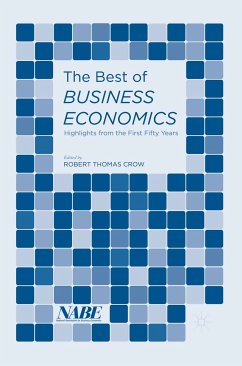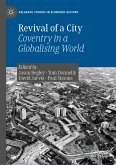The Best of Business Economics (eBook, PDF)
Highlights from the First Fifty Years
Redaktion: Crow, Robert Thomas


Alle Infos zum eBook verschenken

The Best of Business Economics (eBook, PDF)
Highlights from the First Fifty Years
Redaktion: Crow, Robert Thomas
- Format: PDF
- Merkliste
- Auf die Merkliste
- Bewerten Bewerten
- Teilen
- Produkt teilen
- Produkterinnerung
- Produkterinnerung

Hier können Sie sich einloggen

Bitte loggen Sie sich zunächst in Ihr Kundenkonto ein oder registrieren Sie sich bei bücher.de, um das eBook-Abo tolino select nutzen zu können.
Since its establishment in 1965, Business Economics has been an essential resource for those who use economics in the workplace. Its consistent intent has been to distinguish itself from academic journals by focusing on what is useful to practitioners of economics in their everyday work, and it has risen to become the leading forum for debating solutions to critical business problems, analyzing key business and economic issues, and sharing of best-practice models, tools, and hands-on techniques.
In celebration of the journal's anniversary, The Best of "Business Economics" brings together…mehr
- Geräte: PC
- ohne Kopierschutz
- eBook Hilfe
- Größe: 2.94MB
![Beyond Market and Hierarchy (eBook, PDF) Beyond Market and Hierarchy (eBook, PDF)]() K. Man-BunBeyond Market and Hierarchy (eBook, PDF)73,95 €
K. Man-BunBeyond Market and Hierarchy (eBook, PDF)73,95 €![British Nationalisation 1945-1973 (eBook, PDF) British Nationalisation 1945-1973 (eBook, PDF)]() R. Kelf CohenBritish Nationalisation 1945-1973 (eBook, PDF)40,95 €
R. Kelf CohenBritish Nationalisation 1945-1973 (eBook, PDF)40,95 €![Japanese Management in the Low Growth Era (eBook, PDF) Japanese Management in the Low Growth Era (eBook, PDF)]() Japanese Management in the Low Growth Era (eBook, PDF)73,95 €
Japanese Management in the Low Growth Era (eBook, PDF)73,95 €![Service Franchising (eBook, PDF) Service Franchising (eBook, PDF)]() Ilan AlonService Franchising (eBook, PDF)73,95 €
Ilan AlonService Franchising (eBook, PDF)73,95 €![The Future of Housing Markets (eBook, PDF) The Future of Housing Markets (eBook, PDF)]() Leland S. BurnsThe Future of Housing Markets (eBook, PDF)40,95 €
Leland S. BurnsThe Future of Housing Markets (eBook, PDF)40,95 €![Revival of a City (eBook, PDF) Revival of a City (eBook, PDF)]() Revival of a City (eBook, PDF)73,95 €
Revival of a City (eBook, PDF)73,95 €![Eurasian Business and Economics Perspectives (eBook, PDF) Eurasian Business and Economics Perspectives (eBook, PDF)]() Eurasian Business and Economics Perspectives (eBook, PDF)113,95 €
Eurasian Business and Economics Perspectives (eBook, PDF)113,95 €-
-
-
In celebration of the journal's anniversary, The Best of "Business Economics" brings together forty of the best articles from half a century of publication: those that pushed boundaries, challenged conventional wisdom, and redefined the way practitioners and academics approached their work. Much of the insight afforded in this collection on the uses and limitations of economics are as fresh and useful today as when they were published. Featuring award-winning articles and the world's premier economists, this collection is an essential addition to any economics library.
Dieser Download kann aus rechtlichen Gründen nur mit Rechnungsadresse in A, B, BG, CY, CZ, D, DK, EW, E, FIN, F, GR, HR, H, IRL, I, LT, L, LR, M, NL, PL, P, R, S, SLO, SK ausgeliefert werden.
- Produktdetails
- Verlag: Palgrave Macmillan US
- Seitenzahl: 480
- Erscheinungstermin: 8. April 2016
- Englisch
- ISBN-13: 9781137572516
- Artikelnr.: 44919301
- Verlag: Palgrave Macmillan US
- Seitenzahl: 480
- Erscheinungstermin: 8. April 2016
- Englisch
- ISBN-13: 9781137572516
- Artikelnr.: 44919301
- Herstellerkennzeichnung Die Herstellerinformationen sind derzeit nicht verfügbar.
PART I: 1965-1974
1. A New Look At Monetary and Fiscal Policy (1967); Paul A. Volcker
2. The Role of Money in Economic Activity: Complicated or Simple? (1969); Edward M. Gramlich
3. Econometric Model Building for Growth Projections (1969); Lawrence R. Klein
4. President's Message (1970); Alan Greenspan
5. The Social Significance of Environmental Pollution (1970); Barry Commoner
6. The Productivity Slow-Down (1971); John W. Kendrick
7. Why Productivity is Important (1973); Geoffrey H. Moore
PART II: 1975-1984
8. Presidential Address: NABE and the Business Forecaster (1975); Robert G. Dederick
9. Thoughts on Inflation: The Basic Forces (1975); Gottfried Haberler
10. The Practical Use of Economic Analysis in Investment Management (1975); Edmund A. Mennis
11. On Human Welfare (1979); Albert G. Matamoros
12. Company Total Factor Productivity: Refinements, Production Functions, and Certain Effects of Regulation(1981); Douglas L. Cocks
13. Conservatives, Economists, and Neckties (1983); Herbert Stein
14. Economics From Three Perspectives (1982); Marina v.N. Whitman
15. Was Adam Smith a Monetarist or a Keynesian? (1984); Charles P. Kindleberger
PART III: 1985-1994
16. The Effect of Government on Economic Efficiency (1987); George J. Stigler
17. On the Structure of an Economy (1988); James M. Buchanan
18. Rethinking International Trade (1988); Paul Krugman
19. The Suicidal Impulse of the Business Community (1989); Milton Friedman
20. A Guide to What is Known About Business Cycles (1990); Victor Zarnowitz
21. Some Financial Perspectives on Comparative Costs of Capital (1991); J. Fred Weston
22. Health Insurance Derivatives: The Newest Application of Modern Financial Risk Management (1993); James A. Hayes, Joseph B. Cole and David I. Meiselman
PART IV: 1995-2014
23. An Ambitious Agenda for Economic Growth (1996); Murray Weidenbaum
24. Capitalism and itsDiscontents (1998); Michael J. Boskin
25. Protecting Against the Next Financial Crisis: The Need to Reform Global Financial Oversight, the IMF, and Monetary Policy Goals (1999); Henry Kaufman
26. How the Economy Came to Resemble the Model (1999); Alan S. Blinder
27. What Would Adam Smith Say Now? (2000); Henry Kaufman
28. Information Technology and the U.S. Productivity Revival: A Review of the Evidence (2001); Kevin J. Stiroh
29. Understanding Inflation: Lessons From My Central Banking Career (2002); Harvey Rosenblum
30. Managing Exchange Rates: Achievement of Global Re-Balancing or Evidence of Global Co-Dependency? (2004); Catherine L. Mann
PART V: 2005-2015
31. The Explanatory Power of Monetary Policy Rules (2007); John B. Taylor
32. Adam Smith and the Political Economy of a Modern Financial Crisis (2008); Michael Mussa
33. Underwriting, Mortgage Lending, and House Prices: 1996-2008 (2009); James A. Wilcox
34. The Impact of the Housing Market Boom and Bust on Consumption Spending (2010); Jeremy A. Leonard
35. Macroprudential Supervision and Monetary Policy in the Post-Crisis World (2010); Janet L. Yellen
36. Nightmare on Kaiserstrasse (2011); Kenneth Rogoff
37. Financial Services and the Trust Deficit: Why the Industry Should Make Better Governance a Top Priority (2013); Roger W. Ferguson, Jr.
38. U.S. Economic Prospects: Secular Stagnation, Hysteresis, and the Zero Lower Bound (2014); Lawrence H. Summers
PART VI: FEATURE ARTICLES
39. Focus on Industries and Markets: Electric Power Transmission and Distribution Equipment (2011); David A. Petina, Michael Murphy, Andrew C. Gross
40. Focus on Statistics: Initial Results of the 2012 Economic Census (2014); Robert P. Parker
41. Economics at Work: Economics at the American Chemistry Council (2014); Thomas Kevin Swift
PART I: 1965-1974
1. A New Look At Monetary and Fiscal Policy (1967); Paul A. Volcker
2. The Role of Money in Economic Activity: Complicated or Simple? (1969); Edward M. Gramlich
3. Econometric Model Building for Growth Projections (1969); Lawrence R. Klein
4. President's Message (1970); Alan Greenspan
5. The Social Significance of Environmental Pollution (1970); Barry Commoner
6. The Productivity Slow-Down (1971); John W. Kendrick
7. Why Productivity is Important (1973); Geoffrey H. Moore
PART II: 1975-1984
8. Presidential Address: NABE and the Business Forecaster (1975); Robert G. Dederick
9. Thoughts on Inflation: The Basic Forces (1975); Gottfried Haberler
10. The Practical Use of Economic Analysis in Investment Management (1975); Edmund A. Mennis
11. On Human Welfare (1979); Albert G. Matamoros
12. Company Total Factor Productivity: Refinements, Production Functions, and Certain Effects of Regulation(1981); Douglas L. Cocks
13. Conservatives, Economists, and Neckties (1983); Herbert Stein
14. Economics From Three Perspectives (1982); Marina v.N. Whitman
15. Was Adam Smith a Monetarist or a Keynesian? (1984); Charles P. Kindleberger
PART III: 1985-1994
16. The Effect of Government on Economic Efficiency (1987); George J. Stigler
17. On the Structure of an Economy (1988); James M. Buchanan
18. Rethinking International Trade (1988); Paul Krugman
19. The Suicidal Impulse of the Business Community (1989); Milton Friedman
20. A Guide to What is Known About Business Cycles (1990); Victor Zarnowitz
21. Some Financial Perspectives on Comparative Costs of Capital (1991); J. Fred Weston
22. Health Insurance Derivatives: The Newest Application of Modern Financial Risk Management (1993); James A. Hayes, Joseph B. Cole and David I. Meiselman
PART IV: 1995-2014
23. An Ambitious Agenda for Economic Growth (1996); Murray Weidenbaum
24. Capitalism and itsDiscontents (1998); Michael J. Boskin
25. Protecting Against the Next Financial Crisis: The Need to Reform Global Financial Oversight, the IMF, and Monetary Policy Goals (1999); Henry Kaufman
26. How the Economy Came to Resemble the Model (1999); Alan S. Blinder
27. What Would Adam Smith Say Now? (2000); Henry Kaufman
28. Information Technology and the U.S. Productivity Revival: A Review of the Evidence (2001); Kevin J. Stiroh
29. Understanding Inflation: Lessons From My Central Banking Career (2002); Harvey Rosenblum
30. Managing Exchange Rates: Achievement of Global Re-Balancing or Evidence of Global Co-Dependency? (2004); Catherine L. Mann
PART V: 2005-2015
31. The Explanatory Power of Monetary Policy Rules (2007); John B. Taylor
32. Adam Smith and the Political Economy of a Modern Financial Crisis (2008); Michael Mussa
33. Underwriting, Mortgage Lending, and House Prices: 1996-2008 (2009); James A. Wilcox
34. The Impact of the Housing Market Boom and Bust on Consumption Spending (2010); Jeremy A. Leonard
35. Macroprudential Supervision and Monetary Policy in the Post-Crisis World (2010); Janet L. Yellen
36. Nightmare on Kaiserstrasse (2011); Kenneth Rogoff
37. Financial Services and the Trust Deficit: Why the Industry Should Make Better Governance a Top Priority (2013); Roger W. Ferguson, Jr.
38. U.S. Economic Prospects: Secular Stagnation, Hysteresis, and the Zero Lower Bound (2014); Lawrence H. Summers
PART VI: FEATURE ARTICLES
39. Focus on Industries and Markets: Electric Power Transmission and Distribution Equipment (2011); David A. Petina, Michael Murphy, Andrew C. Gross
40. Focus on Statistics: Initial Results of the 2012 Economic Census (2014); Robert P. Parker
41. Economics at Work: Economics at the American Chemistry Council (2014); Thomas Kevin Swift







